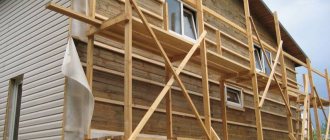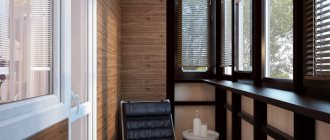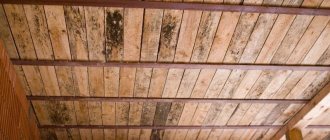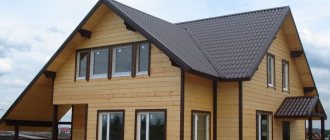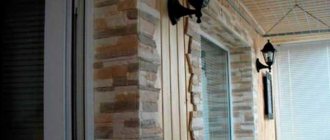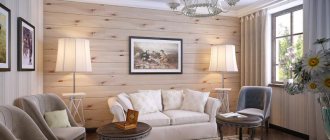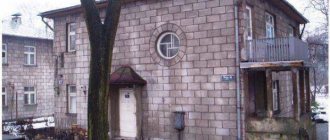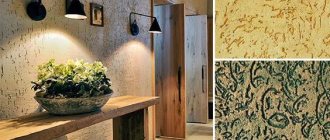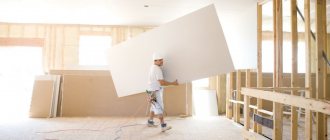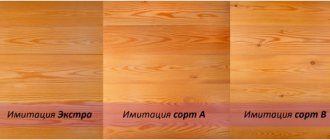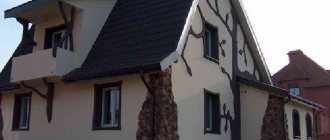Timely covering of the balcony simultaneously solves a number of problems. Firstly, the old almost collapsed bricks are no longer visible from the outside. Secondly, after the work is completed, the structure becomes protected from collapses. This measure helps to retain heat inside the living space, as well as to protect it from the influence of the external environment. Therefore, to give a beautiful appearance to the facade of the house, you need to sheathe the outside of the balcony.
Upper belt
If the balcony slab is not skewed and the lower belt is not needed immediately, we now make it from timber onto the sheathing, as described above.
Again, the height of the lower belt is at least 80 mm, i.e. it needs to be made from two or three rows of timber. We measure how many WHOLE strips of siding will fit along the height of the fence, from the top edge of the bottom chord. Siding, unlike lining, cannot be cut lengthwise to size. THE TOP EDGE OF THE TOP SIDING MUST APPLY EXACTLY TO THE TOP EDGE OF THE FENCE. Please note that to install the casing you will need at least 20 mm of board.
Therefore, along the upper connection of the balcony railing, you need to make an upper belt from boards 60-100 mm wide. Its outer edge should protrude outward by the thickness of the sheathing, and the inner edge will support the window sill. The upper chord is fastened through the existing holes (through which the railings were attached) with self-tapping screws 6 mm long, 3/4 of the thickness of the upper beam, or, if the upper chord comes out thin, with bolts with heads flush through. It is better to take bolts with wide thin heads (press washers).
But what to do if the edge of the top strip of siding ends up protruding only 10-15 mm, or “falls short” by the same amount? If you don’t fence 200-250 mm of the upper belt, it’s a monkey’s work, and it will be inconvenient later.
In this case, you need to lay another beam below on top of the one already laid. The small space between the lower edge of the starting belt and the bottom of the wooden belt will then be painted over along with the balcony slab, but it will not be visible from below.
landscaping
Today you can easily purchase even exotic plants, but their prices can be exorbitant. Therefore, it will be much more economical to landscape the balcony on your own. To do this, you can grow various flowers and vines. You can use indoor plants as decoration; you just need to find out in advance which flowers can withstand various weather conditions. For example, it is good to grow annual plants in open space. When the balcony faces north, you can place cyclamen and ficus. If the side is south, succulents and cacti will come in handy.
Flower pots will look beautiful in pots or baskets of the same design. When these are not available, you can use a simple wooden box.
For vertical landscaping, you can use a lattice assembled from slats, or a regular chain-link mesh - for climbing plants this is the optimal solution that will serve as an excellent support. The cost of this product is quite cheap.
Below are photos of how you can beautifully decorate a balcony with the help of plants and flowers.
Selection of finishing materials
The attractiveness and durability of the cladding depends on the materials chosen. Exterior finishing is subject to increased requirements for the following characteristics:
- moisture resistance;
- frost resistance;
- strength;
- ease of maintenance.
For exterior decoration of balconies and loggias it offers:
Siding
Practical and attractive material is a popular option for exterior decoration. Among its performance characteristics: flexibility, resistance to moisture and low temperature, strength and durability. Siding is easy to install and retains its decorative appeal for up to 30 years. The coating does not require complex maintenance; it can be cleaned with water and detergent. A wide range of colors provides unlimited possibilities for choosing finishes.
Vinyl lining
A practical modern finishing option is moisture resistant, increases the thermal insulation of the balcony, and is not sensitive to frost and wind. Vinyl lining, due to its installation features, creates an attractive sealed coating. Affordable prices and a large selection of colors have ensured the popularity of PVC cladding. Cleaning the lining is done with a soft cloth and detergent without abrasive particles.
Corrugated sheeting with polymer coating
High strength, attractive polyester coating and fire safety are the main advantages of corrugated sheeting. Corrugated steel sheet with decorative coating is resistant to moisture, mechanical stress and ultraviolet radiation. Throughout its service life, the finish does not lose its original color. Affordable cost is one of the significant factors inclining the choice in favor of corrugated sheeting.
To protect the installation seam without complete external cladding of the balcony, the following can be used:
Galvanized sheet (strip up to 330 mm)
Galvanized steel strip is a lightweight and durable material. It does not create a high load on the balcony slab, therefore it is used for cladding structures in old buildings. The advantage of sheet metal is its affordable cost.
White polyester (strip up to 400 mm)
The polymer material provides a neat appearance by covering the installation seam. It is resistant to rain, wind and other natural factors. Polyester does not fade in the sun, is not susceptible to rotting and mold. The low cost of the material makes it accessible to most buyers.
The price includes the cost of materials. The proposed materials are used for exterior finishing of all types of balconies and loggias.
Photo of interior ideas for an open balcony
A selection of modern balcony design options will help you choose the best idea to create a cozy place to relax in a stylish and inexpensive way.
Suitable materials for finishing balconies
Let's consider the most suitable and popular materials for finishing balconies.
Wooden lining
One of the most popular and inexpensive materials used for finishing balconies is wooden lining.
Many people think that this option is already hopelessly outdated, but in fact it has quite a lot of advantages and a small number of disadvantages.
pros
- All the advantages of ordinary wood.
- Easy installation.
- High-quality dried lumber.
- Pleasant appearance, especially when treated with stain.
- Resistant to moisture and temperature changes.
Minuses
- Care is required so that the material does not lose its pleasant appearance over time.
Wooden panels on the balcony
PVC panels
Plastic is another interesting option that can be used to decorate a balcony. This material has its pros and cons:
pros
- Long service life and trouble-free operation.
- Wide selection of shades and patterns.
- Good thermal and sound insulation performance.
- Easy installation and maintenance even for an inexperienced person.
- Adequate price, affordable for many.
Minuses
- Quite fragile.
- Non-ecological material.
- Afraid of the sun and temperature changes.
Plastic panels are a good option that can satisfy the tastes of most. They look modern and have a pleasant appearance. They are easy to install and do not require any special approach during installation.
PVC panels on the balcony
Fake diamond
This material is one of the most interesting options for finishing balconies. It has a pleasant appearance, and the balcony that is decorated with it looks very solid.
Previously, natural stone was considered popular, but only wealthy people could afford it. Artificial stone is a more affordable material.
Artificial stone has the following pros and cons:
pros
- Environmentally friendly.
- A wide range of.
- High strength.
- Resistant to many things.
- Easy installation and maintenance.
- Excellent heat retention performance.
- Resists moisture and temperature changes well.
Minuses
- There are none.
Decorative stones for finishing the balcony
Drywall
Drywall is one of the common materials that is often used in any work related to construction, repair and finishing.
This material is well suited for implementing various ideas, including the construction of non-standard structures.
pros
- A wide range of.
- High strength.
- Easy installation and maintenance.
- Excellent thermal and sound insulation performance.
Minuses
- Poor resistance to wet environments.
This material must be installed on the sheathing to firmly secure it both inside and outside the balcony.
Drywall as a material for finishing a balcony
All skins are good, choose to your taste
Alla Lugoyanova summed up the summary for our round table :
– The choice still comes down to two major building materials market: siding and corrugated sheeting. Moreover, siding is the optimal solution for those who live in an old house, who are limited in funds, who want to update a dilapidated structure without special costs and increased loads on it.
In all other cases, preference should be given to corrugated sheeting as a material that is stronger, more durable, and easier to install and maintain. Although, of course, the aesthetic tastes of the buyer play an important role in this dispute.
For those who are focused on the future and are not afraid of freezing, we can advise making full glazing of the balcony using a frameless method. Well, those who are optimistic about the present should be advised to try out cladding with multi-colored aluminum panels: it’s both fun and problem-free! The main thing is to have time to change the insulating film!
As for the lining, we give it last place in the ranking of preferences: it is for those who have the money and time to take a lot of care of their balcony.
Do-it-yourself exterior cladding
You can cover the balcony block with your own hands. Let's look at the installation process using corrugated sheets as an example:
- First you need to dismantle the old casing. After this, it is necessary to install the sheathing on the metal structures (corner posts located around the perimeter);
- Then you need to drill two holes with a diameter of about 4 mm in each rack. It is necessary to leave no more than 1 mm between them;
- It is recommended to drill holes from the inside of the balcony without going outside;
- This is not at all difficult to do. To do this, you can attach the sheathing to self-tapping screws. Don't forget about this when you go shopping for the necessary fasteners;
- As a result, you should have a double belt made up of boards located around the perimeter;
- The wood must be treated with a special waterproof impregnation;
- Only after these steps can you begin to install ready-made corrugated sheets of the correct sizes;
- The sheets must be screwed using screws with special seals. At the corners, the structure should be decorated with corner profiles;
- It is necessary to adjust the parts using special scissors for cutting metal;
- If there are scratches on the sheets, they can be easily hidden. To do this, you should turn to special waterproof paint.
You can see the process of cladding the outer façade of a balcony more clearly in the following video:
You can also install siding panels yourself. Let's consider the step-by-step installation of such materials:
- First you need to familiarize yourself with the technical condition of the balcony block. It is necessary to carry out restoration work if necessary;
- Siding cannot be installed until you have installed a special frame on which the panels will be attached. Most often it is made up of boards and beams. If funds allow, then a more reliable metal frame can be installed;
- Do not forget about installing high-quality insulation on the balcony;
- After all the preparatory work, you can begin installing the siding. You need to secure the corners at the corners. The side ends of the panels will be installed in them;
- At the bottom of the balcony block you need to attach the starting strip using self-tapping screws. It is on this part that the panels will be attached;
- Next, you need to insert the first sheet of siding into the grooves on the plank. The panel is secured with self-tapping screws on the front side;
- Do not tighten the fasteners all the way. You need to leave about 1-2 mm of free space. This rule must be followed so that in case of exposure to high temperatures, the siding does not become deformed due to the fastener heads;
- In a similar way, it is necessary to continue installation from the bottom to the top.
In the video below you can see the entire process of covering a balcony with siding panels:
If you install all the panels correctly and competently, then there will be no need for additional sealing. Experts recommend sealing all cracks and grooves with sealant before directly installing the panels. This is necessary to provide a high level of protection against moisture, dampness, drafts and low temperatures.
Putting things in order
First, you should look around and assess the situation. Most likely, there are broken equipment on the balcony, seasonal items, old dishes are stored, and there is a clothesline hanging. When the balcony resembles a closet, you should first empty it of all unnecessary rubbish that can be thrown away or distributed.
After the area has been cleared of everything unnecessary, it should be washed and only then plan further development.
Material selection
Do not rush to start work on finishing the balcony. First you have to solve the problem of choosing a material. The modern building materials market offers many options that are suitable for these purposes. Not all of them are equally good, so you will have to study each option and choose the best one.
Plastic lining is the most affordable material, produced in a large assortment and made to order by many companies. Such plastic panels are attached to metal or wooden sheathing. Installation takes a minimum of time and does not require the use of professional tools or specialist assistance. When choosing this material, you should take into account its fragility, which makes transportation inconvenient, and the ability to lose color from exposure to sunlight. And also, due to their lightness, the panels can be torn off by strong gusts of wind.
You can’t ignore the only material that is best not to be used for exterior decoration of a balcony. We are talking about a tree. It may have no equal for other purposes, but in our case the tree is not suitable for several parameters at once. Wood is not highly resistant to moisture and infrared radiation. In addition, it ignites quickly and burns well.
Flooring
If the floor surface on the balcony is perfectly flat, you can use plastic self-adhesive tiles; when there are uneven surfaces, preference should be given to another option.
If you have limited options, an excellent solution would be to use old pallets and wooden slats. The wood should be treated with a protective agent, which will improve the moisture resistance and reliability of the material.
A tufted rubber carpet would also look good. It needs to be laid loosely; for a stronger fixation, you can use double-sided tape.
The photo of a budget balcony shows examples of how you can decorate the space stylishly and beautifully.
Insulation
Having finished the glazing, they begin to insulate the balcony from the inside. If necessary, Penoplex thermal insulating slabs can be used to insulate the floor, ceiling, side walls and parapet.
You can insulate the balcony with penoplex
Extruded polystyrene foam Penoplex with a thickness of about 40 mm is used to insulate an uncombined loggia, and about 60 cm thick for a combined loggia. Penoplex polystyrene foam insulation is very easy to cut and therefore very easy to adjust to the desired size or configuration. Methods of attaching Penoplex to the surface may be different. You can attach Penoplex to the wall using special plastic mushrooms or glue Penoplex to the wall using special glue or foam, or you can attach the insulation to a wooden frame that is pre-attached to the surface. Typically, a wooden frame is made from timber with a cross-section of 40 x 20 mm. Wooden beams must be treated with an antiseptic before use. The timber is secured to the walls using screws and screws. Penoplex must be laid very tightly on the walls so that they are pressed tightly against each other and there are no cracks or gaps between them. Penoplex joints can be sealed with summer polystyrene foam, but winter and universal ones are not recommended since they contain toluene, which dissolves polystyrene foam.
Insulating the loggia with penofol over penoplex
You need to lay a reflective penofol vapor barrier on top of the insulation, and tape the joints between the sheets with tape. Rolled waterproofing Penofol is made of foamed polyethylene and aluminum foil. Instead of Penofol, you can also use foiled polyethylene film. Penofol can be attached using polyurethane glue or double-sided tape. The loggia is insulated with penoplex and covered with penofol on top so that air vapors do not penetrate into the insulation and do not come into contact with the cold wall, since as a result condensation will appear which will be absorbed by both the insulation and the wall, and as a result mold, mildew will appear and everything will begin to collapse. Therefore, a vapor barrier cannot be installed on the cold side of the insulation, that is, between the insulation and the wall. Also, vapor barrier is an additional thermal insulation and waterproofing. If your balcony is on the top floor or your neighbor’s balcony above is not insulated, then it is necessary to insulate the ceiling.
Step-by-step insulation of the loggia with polystyrene foam
Typically, a U-shaped ceiling CD profile or wooden blocks are attached along the ceiling. Then the balcony is insulated with polystyrene foam, which is placed between the plates or bars. The loggia is also insulated with polystyrene foam, which can be attached to construction silicone.
The issue of safety at heights
If the balcony is located on the first floors of the building, their owners can easily carry out all repair and finishing work without resorting to professional high-rise equipment. But what should those who live above the third floor do and do not have the opportunity to hire trained workers for these purposes?
The first thing you need to take care of is to fence off the area under the balcony and hang warning signs. If some part of the materials or tools falls from a great height, and at that moment passers-by are walking under the balcony, dire consequences cannot be avoided.
Next, you should think about ensuring safety for yourself and your assistant (it is strictly forbidden to carry out such work alone; you always need backup). A strong frame, a parapet, a platform with a fence, climbing equipment - the more different safety factors, the better.
No. 3. Metal siding
Metal siding is one of the most durable materials for cladding a balcony. It has a multilayer structure. It is based on a sheet of steel 0.35-0.65 mm thick, galvanized on both sides, coated with a conversion layer, a primer layer and a polymer material. It can be with or without perforation, have a different relief and even imitate the structure of stone, logs or ship timber.
Metal siding today is very popular in covering the balconies of apartment buildings, which is explained by its many advantages:
- attractive appearance;
- resistance to environmental factors. Since the outer layer is not paint, but a polymer coating, it is unnecessary to periodically tint the material;
- excellent performance, incl. resistance to temperature changes, precipitation, sunlight, and mechanical damage. The material is fireproof, not susceptible to the development of fungus and mold, resistant to corrosion;
- Thanks to the presence of locks, installation is simplified.
This material is almost perfect. You can only find fault with the low degree of thermal insulation, because it is metal, and the weight of the structure will be higher than when using plastic, so you need to consider whether the balcony will withstand the additional load.
No. 1. Plastic lining
One of the most popular materials is plastic, which is explained by its affordable price. Made from polyvinyl chloride with or without seams. In addition to the attractive cost , the advantages of the material are as follows :
- good appearance;
- huge selection and availability in any construction store;
- simplicity and speed of installation;
- heat and sound insulation qualities;
- does not change color and shape over time;
- If one lamella is damaged, only it can be replaced without touching other elements.
Sheathing with plastic clapboard can even be done independently - working with the material is quite simple. In addition to standard colors, lining that imitates the structure of wood is also available for sale. Among the disadvantages of the material:
- low durability, which is determined by approximately 15 years of service;
- instability to mechanical damage. The lining can be deformed due to careless installation and operation, so you need to be very careful with it. The good thing is that replacing a damaged element is not that difficult;
- the light weight of the material is not only ease of installation, but also the likelihood that on the upper floors gusts of wind can simply tear off sheets of plastic lining, so it is not recommended to use it above the 3-4 floors.
Exterior finishing of balconies and loggias: how it’s done
The covering of a balcony or loggia largely depends on the type and condition of the enclosing structure. Standard railings are rarely suitable as a base. External finishing of the balcony should begin with strengthening them, eliminating backlashes, and increasing rigidity. The railings can be completely replaced with a new welded structure or even a brick wall. Exterior decoration of loggias often begins with this.
At the same time as strengthening the railings, a canopy is created that removes precipitation and drops from the roof and balconies of the upper floors. To attach the canopy, you can use the overhanging slab of the next floor. If it is not there, the external decoration of the balcony is complemented by the construction of a full-fledged canopy resting on the wall of the house and on the balcony slab. In this case, a single enclosing structure is usually created, which simultaneously serves as the basis for installing glazing.
Sheathing with modern materials requires a special supporting structure. For example, external siding is done using a sheathing consisting of parallel slats or metal profiles mounted at a certain pitch.
The procedure for insulation depends on the design of the fence. Frame structures are usually insulated from the inside after the installation of the external cladding is completed. It is better to insulate a parapet made of bricks or blocks from the outside; in this case, the exterior decoration of the loggia will repeat the usual insulation scheme for a main wall with a curtain facade.
Rules for performing work on exterior cladding of loggias
Before starting work in old houses, you should definitely get professional advice on the technical condition of the structure. Depending on the expert’s opinion, a decision is made on the type of material that can be safely used for the exterior decoration of the loggia. Particular attention is paid to the condition of the balcony slab, the integrity of the concrete, and the condition of the reinforcing layer. The more severe the damage, the less weight the foundation can support.
Balcony in disrepair
After the preliminary inspection, you can begin planning and preparing materials. Basic rules for carrying out work:
Coordinate the work with your neighbors
Attaching vinyl siding
When the wooden frame is ready, installation work should begin. To make the outer skin “walk around” less, you should leave the siding on the balcony before installation. The material will react to air temperature and expand. This will reduce the warping of the skin and almost completely eliminate the harmful effects of temperature changes.
Next, the installation of corner profiles and the starting strip begins. They are fastened with zinc coated self-tapping screws. This allows you to obtain a durable connection that is not subject to corrosion. The corner elements and the starting strip must be accurately aligned using a building level. The quality of subsequent siding installation depends on this.
Siding installation
Vinyl siding goes up pretty quickly. But you should follow some rules, thanks to which the cladding will last as long as when working with corrugated sheets. The main “law” is to leave a gap at the junction of panels and additional elements. The distance should be within 1 cm, which will prevent swelling when the siding expands.
The next thing the master should remember is the process of tightening the screws. They are located exactly in the center of a special mounting hole to allow the vinyl panel to expand or contract. In addition, the caps should not be screwed tightly, otherwise the siding will not be able to move freely. You shouldn’t forget about this before covering your balcony with siding yourself. Otherwise, the process does not present any difficulty, since the panels have special locks with which they are connected to each other.
The set of each subsequent element must be accompanied by a mandatory check for horizontalness. If you allow a misalignment, this will be reflected in the final stage, when windows are installed at the top. The curvature can only be corrected by completely disassembling the entire casing, which will take some time.
The last panel should have a margin in width. This step is needed for more precise fitting and finishing of the parapet when glazing it. The reserve can reach three centimeters.
You can't go anywhere without a tool
The material has been selected, which means it’s time to prepare the necessary tools. Regardless of the type of cladding used on the balcony, any craftsman will find the following useful:
- building level;
- electric drill or hammer drill;
- jigsaw or hacksaw;
- hammer;
- screwdriver;
- metal scissors (if the work will be carried out with corrugated sheets);
- tape measure and pencil.
If there is no tool listed on the list, then do not despair. For example, a screwdriver can be replaced with screwdrivers, although the work will be done a little slower. To do everything quickly and with maximum quality, you should go to the nearest store, where you can fill in the gaps in the “tool park”.
What is needed to decorate a balcony
Before you start finishing the balcony from the outside, you need to be well prepared. For work you will need the following tools and equipment:
- tape measure and building level;
- wood hacksaw with fine teeth;
- hacksaw and metal scissors;
- hammer drill with drills for wood, metal and concrete, screwdriver;
- hammer;
- construction stapler;
- Bulgarian.
The first stage of exterior finishing of the balcony is preparatory. The surface to be coated must be treated as follows:
- Clean the base of the balcony, remove old railings and finishing materials. If necessary, weld the cracks and clean the joints.
- Remove rusty deposits from areas of the metal balcony base and prime.
- Eliminate faults, level the base using a concrete solution.
After preparation, you need to install the sheathing. It will serve as a frame for the finishing material.
The outer covering of the balcony with metal siding is carried out in stages. The first stage is strengthening or replacing the railings, the next is installing the sheathing. You won’t be able to do all the work alone; you need someone to hold and hand you the necessary tools. The sheathing should be attached to the metal railings.
To install the sheathing, you need:
- Drill 2 holes (less than 4 mm in diameter) on each rod and stand. The distance between the holes should be in the range of 1000–1200 mm. They should be placed strictly on the same line.
- Attach a wooden beam with a cross-section of 20 x 40 mm using self-tapping screws (through the holes prepared in the previous step). The beam must have a length equal to the length of the balcony. The result will be 2 rows of beams with crossbars on each rod. The bottom rail should be mounted at such a level that it can be reached without any problems. When installing metal siding using a drill, it is necessary to ensure a distance of approximately 0.5 m.
Features of cladding from the street
Having decided what material will be used to decorate the outside of the balcony, you need to prepare all the necessary tools. So, when starting work, you can’t do without:
During installation, rope is often used; with its help, the material lies more evenly.
Before starting the main stage of work, the closed balcony needs to be strengthened. For this, a metal frame is used; it is often attached directly to concrete walls. Working with this type of cladding requires enormous effort and welding skills. After all, it is initially necessary to make a metal frame and only then attach the skin directly on top of it. When metal corrugated sheeting is used, the sheathing of beams can be omitted, since the structure will be strengthened due to the material used.
Regardless of what type of balcony is covered, this work has a number of features. Experts have compiled detailed step-by-step instructions for this. So, the old cladding is removed from the railings, observing safety precautions. The slab under your feet is initially repaired, and only then pulled together. To do this, a special beam is placed along its entire length. Most often it is made of wood and the structures are held together with tongue and groove. Meanwhile, wooden beams are placed on the upper surface of the balcony, thereby creating the so-called frame.
Anything made of metal must be pre-painted . Holes for self-tapping screws are made on the material that will be attached, thereby creating additional convenience for installation. Using a drill, it is attached to the frame, joining them together so that there are no gaps or cracks.
After the fastening stage is completed, cladding begins. Then special fittings and fasteners are attached to the edges.
The loggia also needs cladding. Making it is somewhat more difficult than for a regular long balcony. One of the features is the fact that you should not forget about the hinged protection. So, in order for the loggia to be closed, hinged canopies are often used (for more details, see the article “how to make a canopy on the balcony”). In order to install them, you can bring the planks to the top, and subsequently cover everything with plastic or, conversely, lay a slate floor. What is important is that in the case when metal profiled sheets are used for cladding, you do not have to install a wooden frame. This is done when the metal structure is initially tightly made. Better made of iron.
If a closed balcony that has glazing is sheathed, then if a sealed space is formed it can be used as another room, which adds an advantage to this type of finishing. But you need to decide on the interior design.
Exterior finishing: functionality and design
When planning a major overhaul or complete reconstruction, take into account the design features of the façade of the house and the methods of glazing in neighboring apartments. If all floors sparkle with white vinyl siding, it is hardly appropriate to decorate the outside of the balcony with wooden paneling with openwork carvings. Or sheets of corrugated sheets painted poisonous green. Particular care is required when interfering with the appearance of a historical building - against the backdrop of luxurious balustrades and stucco cornices, cheap plastic will look ridiculous and tasteless.
The atmosphere inside the room, especially temperature and humidity, depends on the cladding method. A thin layer of plastic will only protect from precipitation, and then only for a short period. Decorating the outside of the balcony with expensive materials, additional insulation and waterproofing guarantee a comfortable temperature and optimal humidity for a long time.
Balcony insulation with penoplex
When drawing up an “internal” project for a future additional room, do not forget about the exterior decoration. The safety of the concrete screed, walls, flooring, and the appearance of the building as a whole depends on it.
Balcony decoration: budget renovation ideas
If funds are limited, but at the same time there is an irresistible desire to make the balcony stylish and cozy, then the question arises, how can you inexpensively and beautifully decorate the space?
Many people prefer to store unnecessary things on the balcony or grow plants, trying to turn a small area into a small analogue of a summer cottage. However, dachas were invented for the purpose of relaxation amidst nature. A balcony room can be easily converted into a relaxation area if you use professional design techniques and small tricks.
Metal finish
Sheathing a balcony with painted corrugated sheeting is as easy as vinyl siding. It’s even easier, especially if you have an assistant. The frame for this type of siding is made according to exactly the same principle as in the case of vinyl siding. The strength of the new base can be achieved using wire or special galvanized clamps that secure wooden blocks.
Installation work when sheathing a parapet with sheeting begins with the installation of the sheets themselves. To do this, use roofing screws that have the same color as the material itself. The correct installation is checked by a building level, which is applied to the upper edge of the metal sheet. Screw the screws through the wave. This is enough to obtain a strong connection.
When all the sheets are fixed in place, additional decorative elements are attached. This is precisely what distinguishes the process of covering a balcony with vinyl panels and corrugated sheets.
Work begins with dismantling
Before covering the balcony with siding from the outside, you need to remove all interfering elements. Any materials located on the parapet, as well as objects that could interfere with work, must be dismantled. As a result, there should be nothing left on the balcony except a metal frame, which is a fence.
Next, you should carefully inspect the concrete slab and parapet. If cracks, shedding or rust are noticed, they must be eliminated so as not to weaken the future structure in the future. The old metal parapet needs to be strengthened. A galvanized strip is perfect for this; it can be used to strengthen the connection between the concrete slab and the old fence.
Afterwards you will need to coat the metal with a primer, having previously cleared it of any existing paint. Concrete should also be covered with an anti-corrosion compound to prevent any destructive processes. Once these steps are completed, you can move on to the next stage of work.
Insulation methods
Balcony insulation is usually carried out indoors. However, in this case, the area of the internal space decreases. Therefore, it is recommended to insulate small balconies from the outside.
Various materials are used for insulation:
- Foam is often used as a heat-insulating material. Sheets are available in different sizes and thicknesses. Therefore, everyone chooses the most convenient dimensions of the plates for the job. Polyfoam does not react to increased humidity, so it can be used even in regions with harsh climates;
- expanded polystyrene is a type of foam with increased strength, moisture resistance and fire safety characteristics. Its advantage is the possibility of plastering with various mixtures, including decorative compounds;
- mineral wool is a hygroscopic material with insulating properties. Insulation work becomes more complicated, as it becomes necessary to use vapor barrier and waterproofing layers.
The use of insulation significantly improves the quality of stay on the balcony.
Finishing the external walls of the loggia
Exterior decoration is no less important. Its main purpose is to protect the structure from environmental influences (primarily to prevent moisture from entering).
The most popular options for exterior finishing are:
- Plastic lining. This is a budget finishing option that allows you to cover the external surface of an insulated or extended balcony. Positive properties include low price, ease of installation, moisture resistance and a varied selection of colors. However, it should be borne in mind that plastic lining is a material intended for interior work.
- Siding differs from plastic lining in appearance. It is attached horizontally to the sheathing. At the same time, siding has high resistance to weather conditions. Other advantages include ease of installation and moisture resistance. Don’t forget about easy care and resistance to mold and mildew. Thermal insulation and sound insulation of the material, strength and resistance to temperature changes, and service life are also important.
- You can sheathe the structure with corrugated sheets. It is not so aesthetically pleasing, but it is accessible and practical. It protects from moisture and dust, but does not provide the necessary degree of heat due to the lack of an insulating layer inside.
Any of the options allows you to protect the structure from premature deterioration.
Which color is better to choose?
An important point when choosing curtains or other devices to protect a balcony from the sun is their color, since it also affects the reflective effect.
Preference should be given to light, but not bright shades of curtains or blinds
First of all, it is recommended to abandon dark colors, since such materials tend to absorb heat, so the balcony and rooms will not only be dark, but also stuffy. Thus, there is a risk of getting a small “sauna” on the balcony instead of the desired coolness, which is completely impossible to be in. Therefore, black, dark blue, burgundy, dark brown and similar colors should be avoided.
It is recommended to choose light pastel colors - blue, light green, soft green, beige, ocher, white, cream and lilac shades.
You should not cover the windows with curtains or blinds that have bright warm colors - orange or yellow, they will “psychologically” enhance the sunlight and will not create the desired atmosphere of coolness.
In addition, you should take into account the creation of harmony in the color of the protective devices on the windows with the rest of the interior design of the balcony.
Decorative plaster
A traditional option for wall decoration can be called decorative or relief plaster. This material is produced in a wide range, and is applied with varying depths and complexity of relief. This type of coating is at the same time protective, as it protects the walls from the penetration of moisture and dust.
It is very important that having applied the plaster solution to the walls once, the owner is free to change the color of the finish at any time, since re-painting the surfaces will not be difficult. To change the color scheme you only need water-based paint, a brush and a roller
Furniture
As furniture, you should feel free to use items that can visually replace it. For example, a small sofa can be built using pallets. The role of a cabinet can be perfectly fulfilled by a fruit box, which, if desired, can be opened with wood paint. If the apartment has old shelves, unnecessary shelves, chairs, they should be refreshed in any shade and assembled from them into a convenient original composition.
If you plan to purchase new furniture, preference should be given to furniture that is intended for use in the country. Folding inexpensive copies will help you cope with the task. The color palette can be changed at any time, since the cost of alkyd universal paints is quite reasonable.
How to cover the outside of a balcony cheaply and beautifully: what do you need for this?
The outer cladding of the balcony significantly increases the attractiveness of ceilings and walls and improves the microclimate of the living space. When choosing exterior decoration for a balcony, you should be very careful in choosing the characteristics of materials and elements that are located outside the building, especially those that are exposed to natural factors.
The price of external cladding is slightly higher than internal cladding due to its specificity and complexity of installation. Options:
- Vinyl siding. Presented in 2 versions. Traditional - boards with additional fastenings. Facade - slab type with raw edges (imitation rocks, masonry). Service life from 15 years on the sunny side. Frost-resistant and does not fade from exposure to sunlight. A significant advantage is that installing siding does not require additional insulation of the living space. Sheathing is inexpensive for the apartment owner.
- Wood paneling. Mid-price segment option. Wood requires additional and special care. For exterior work with wooden cladding, it is worth stocking up on antiseptic and protective agents. It should be treated before installation, otherwise problems and health hazards may occur during high-altitude work. The ends of the boards require additional processing.
- Profiled sheeting. Metal sheet cladding material with a long service life. The sheets are protected from rust and other environmental factors. Serves from 15 to 30 years. The price for this type of cladding is high, but with long-term use the material fully pays for itself.
- Frost-resistant lining. Considered one of the best solutions available on the market. Serves for more than 10 years, depending on the climate. Does not lose its properties under rain, wind, snow. Maintains appearance and integrity in hot and cold weather. Susceptible to fading: if installed on the sunny side, there is a high probability of fading after 2-4 years.
The choice is influenced only by the available repair budget, taking into account the needs of the owner.
Preparatory work and necessary tools
For any construction and renovation, the premises must be prepared. The same applies to balconies, or rather, to a special extent.
The fact is that repairs and finishing most often require balconies of old housing stock. In such houses, the structures have not been repaired for decades, and many floors can be dangerous for use.
Therefore, the first thing you should do is check the quality of the floors and the balcony base slabs. If an assessment of the load on them during high-altitude work shows a disappointing option, the arrangement will have to begin with a major overhaul.
If these problems bypassed your balcony, you should perform a number of preparatory work:
- clean the base plate;
- clean all joints and cracks from debris and dust, weld them and seal them;
- remove old railings;
- remove old coatings;
- clean and prime the rust on the metal parts of the frame;
- level the base with concrete mortar.
Materials
Laminate
Many apartment owners today are turning to laminate finishing. Such options should be used to decorate the inside of the balcony, since they are made of wood. Modern manufacturers offer consumers a wide variety of laminate flooring in different styles.
This type of cladding is used for both floors and walls. She is not afraid of temperature changes and exposure to sunlight.
Laminate does not require special care. It is easy to clean and does not accumulate dust. It is worth noting the fact that today such cladding can be selected to suit any budget.
Wood
Wood cladding is very common. The most common and popular materials are lining, eurolining, terrace boards or panels imitating timber and block house. They differ from each other not only in appearance, but also in the method of fastening.
Lining
The lining has a long service life. If you provide it with proper care, it will serve you for decades. But it is worth remembering that approximately once every 3-5 years you will have to restore and update its surfaces.
Lining is a practical material. This property directly depends on the type of surface. For example, the presence of a special dirt-protecting film makes it easier to maintain the cladding. It is not so easy to clean dirt from simple panels.
For external cladding, wood should only be used if you are decorating the balcony of a private house made of wood.
MDF panels
MDF panels are also made from wood. They are in many ways similar to lining and are more advanced fiberboards. A distinctive characteristic of MDF panels is the presence of a special laminating film - it makes the material moisture resistant.
Modern manufacturers offer several options for fiberboards. They come in flat shapes with a protective polymer layer on the front side and panels with relief patterns.
The main advantages of MDF panels are their low cost and ease of installation. Installing such a finish will take you a minimum amount of time and effort. No preparatory work is required for such material.
No. 5. Wooden lining
Natural wood is not the most popular material for cladding balconies, which is due to its low resistance to numerous negative natural factors. This fact is the main disadvantage of wood , but modern technologies make it possible to use special impregnations in the production of wooden lining that protect the wood from moisture, rotting, pest damage and make it more resistant to fire. However, owners of balconies with such cladding will have to regularly care for the material so that it remains in its original form for as long as possible.
Among the main advantages of wooden lining:
- beautiful appearance that can enhance any balcony;
- environmental friendliness;
- heat and sound insulation properties.
Such cladding is unlikely to be appropriate when arranging a balcony in a typical apartment building, but for a small private house it is very suitable.
